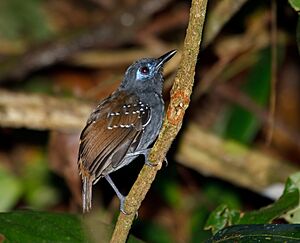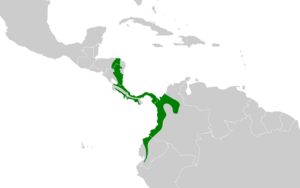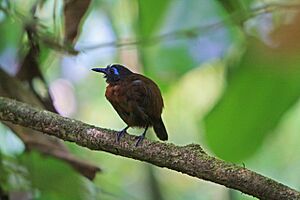Chestnut-backed antbird facts for kids
Quick facts for kids Chestnut-backed antbird |
|
|---|---|
 |
|
| Conservation status | |
| Scientific classification | |
| Genus: |
Poliocrania
|
| Species: |
exsul
|
 |
|
| Synonyms | |
|
Myrmeciza exsul |
|
The chestnut-backed antbird (Poliocrania exsul) is a small passerine bird. It belongs to the antbird family. You can find this bird in humid forests. It lives in parts of Central and South America. Its range stretches from eastern Nicaragua to western Ecuador. These birds usually live in low-lying areas. They can be found up to about 900 meters (2,950 feet) high.
This bird is common in wet forests. It likes thick bushes in the understory. You might see it at forest edges, near streams, or in old clearings. It also lives in tall, regrowing forests. The female antbird lays two white eggs. These eggs have purple or red-brown spots. Both parents take turns sitting on the eggs to keep them warm. Their nest is a messy cup made of vines, plant fibers, and dead leaves. It is placed low in the plants. Both the male and female parents feed their young chicks.
What Does the Chestnut-backed Antbird Look Like?

The chestnut-backed antbird has a strong body and a short tail. It is about 14 centimeters (5.5 inches) long. It weighs around 28 grams (1 ounce). Both male and female birds have a pale blue patch of bare skin around each eye.
The adult male has a blackish head, neck, and chest. The rest of his upper body, wings, and tail are a rich chestnut color. His sides and lower belly are a slightly darker brown. The female has a brownish-black head and neck. But this dark color does not go down to her chest. Her underparts are a darker chestnut in some areas. In other places, like Costa Rica and Panama, her underparts are more reddish-brown. Young birds look duller and grayer than the adults.
Some chestnut-backed antbirds have white spots on their wings. These are like two wing bars. You can find these birds in parts of Panama, Colombia, and Ecuador. They were once thought to be a different species. But scientists found they sound very similar to the birds without spots. Also, these two groups of birds can have babies together where their homes meet.
Antbird Sounds and Habits
This bird makes a rough "naar" sound. The male's song is a whistled "peeet peeew." The female answers with a higher-pitched version of the same song.
Chestnut-backed antbirds usually live in pairs all year round. Sometimes, they join groups of different bird species that are looking for food together. They might also follow army ants. They eat insects and other small creatures like spiders. Sometimes, they even eat small frogs or lizards. They find their food in leaf litter and tangled vines low in the plants or on the ground.
It can be hard to see this bird because it lives in dense forests. But it is easier to hear its calls. You can attract it by whistling its song. If you do, it might puff up its body, droop its wings, and pump its tail. This is a way for it to show its territory.
How Scientists Name Birds
The chestnut-backed antbird was first described by an English zoologist named Philip Sclater in 1859. He gave it the scientific name Myrmeciza exsul.
Later, in 2013, scientists studied the bird's DNA. They found that the group of birds called Myrmeciza was not organized correctly. To fix this, the chestnut-backed antbird was moved to a new group called Poliocrania. The name Poliocrania comes from ancient Greek words. Polios means "ash-gray" and kranion means "head" or "skull." This new group only has one species in it.
There are five different types, or subspecies, of the chestnut-backed antbird:
- P. e. exsul (Sclater, PL, 1859) – Found from eastern Nicaragua to western Panama.
- P. e. occidentalis (Cherrie, 1891) – Found in western Costa Rica and southern Panama.
- P. e. cassini (Ridgway, 1908) – Found in southeast Panama and northern Colombia.
- P. e. niglarus (Wetmore, 1962) – Found in eastern Panama and northwest Colombia.
- P. e. maculifer (Hellmayr, 1906) – Found in western Colombia and western Ecuador.


